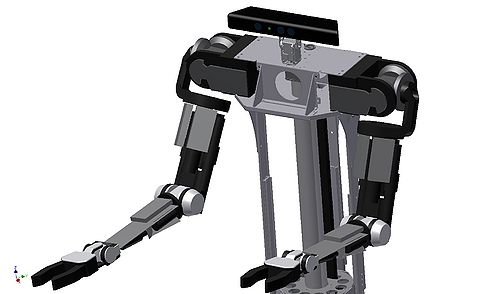AMIGO Head
| Part Links |
| Author |
| TU/e |
| CST Group, TU/e |
| rop@tue.nl |
| CAD Files |
| Inventor |
| STEP |
| Electrical Drawings |
| License |
| License Files |
AMIGO: Head | Arms | Torso | Base
Contents |
Part Summary
Microsoft's Kinect is used as a head to get a visualization of the world.
- Author: CST Group, TU/e
- License: CERN OHL v.1.1
- Repository: https://gitlab.tue.nl/tech-united-eindhoven/rop/-/tree/master/AMIGO/Head
- Software: http://www.ros.org/wiki/Robots/AMIGO
Overview
In order to recognize objects and to create a three dimensional visualization of the environment, AMIGO is equipped with a Microsoft's Kinect (1) camera. In the same way humans do, the images out of multiple cameras are used for depth perception. Two Dynamixel RX-28 actuators to make it able for AMIGO to look around. A Picture of the CAD model is shown in figure 1.
Specifications
Construction
- Dimensions (HxDxW): 16 x 6 x 16 cm
- Weight: +/- 1 kg
Vision
Microsoft Kinect
- Horizontal field of view: 58 degrees
- Vertical field of view: 45 degrees
- Image sensor: Resolution VGA (640 x 480)
- Frame Rate 30 fps
- Depth sensor: Resolution VGA (640 x 480)
- Frame Rate: 30 fps
- Range: 0.8 - 3.5 m
- Spatial x/y resolution: 3 mm (@ 2m distance)
- Depth z resolution: 1 cm (@ 2m distance)
Software
- Ubuntu
- ROS (Robot Operating System)
- Programming: C++
Communication
- USB
- RS48 via EtherCAT stack
Degrees of Freedom
Pan Tilt Head
- Pan: 300 degrees
- Tilt: 120 degrees
Motor Specifications
Neck - 2x Dynamixel RX-28
Mechatronics
Assembly of the Head
Figure 2 shows AMIGO's head.
Microsoft's Kinect camera (1) is bolted via a support plate to a Dynamixel RX-28 (3) using a standard FR07-H101 frame (2). These parts are bolted using the supplied bolts that come with the frame. This Dynamixel (3) makes it possible for the robot to look up and down. In order to look to the sides a second Dynamixel Rx-28 (5) is used. Both Dynamixels are connected using a FR07-S101 frame (4). Figure 3 shows the positioning of the head on the torso. The Dynamixel (5) is bolted to the upper body's top panel.
License
Copyright Technische Universiteit Eindhoven 2011.
This documentation describes Open Hardware and is licensed under the CERN OHL v. 1.1.
You may redistribute and modify this documentation under the terms of the CERN OHL v.1.1. (http://ohwr.org/cernohl).
This documentation is distributed WITHOUT ANY EXPRESS OR IMPLIED WARRANTY, INCLUDING OF MERCHANTABILITY, SATISFACTORY QUALITY AND FITNESS FOR A PARTICULAR PURPOSE. Please see the CERN OHL v.1.1 for applicable conditions.




